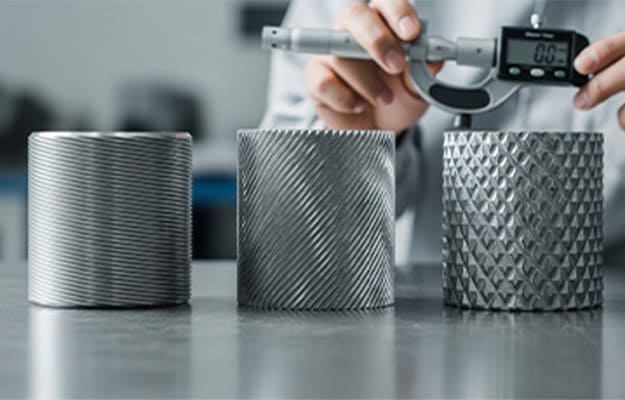A common challenge in the manufacturing industry is achieving both a functional grip and reliable assembly in high-precision applications. Inconsistent surface textures and unstable fastening often lead to product failure, increased rework costs, and ultimately damage a company’s reputation and profits.
However, there is a proven solution: knurling. It not only enhances the user experience but also increases the stability of mechanical assemblies. An often-underestimated turning process, knurling is widely used in CNC lathes and automatic turning operations. It can quickly transform smooth surfaces into textured ones, meeting the dual functional and aesthetic demands of industries ranging from medical devices to consumer electronics.
This article will delve into the knurling process, type classification, key advantages, and typical application scenarios. By integrating the practical needs of CNC machining processes, we will provide key information on selection, design, and implementation, helping companies improve product performance, optimize production efficiency, and achieve more competitive manufacturing solutions.
What is Knurling?
Knurling is a common machining process, typically performed on CNC lathes. It involves using a specialized knurling tool to create a regular pattern, such as straight, diagonal, or diamond-shaped, on the surface of a workpiece. This creates a rough, regular pattern on the surface of an otherwise smooth metal, increasing friction, facilitating manual operation, and strengthening the bond between parts. Beyond its practical functions, knurling can also provide decorative effects, adding a touch of elegance and sophistication to parts.
Knurling’s core purpose is to increase friction and surface adhesion, which are critical in many industries. For example, knobs on medical devices require a better grip, parts in electronic products require more secure assembly, and even aviation components use knurling to enhance fastening. Knurling can be performed as either a cold extrusion process or a cut-knurling process, depending on the material and precision requirements.
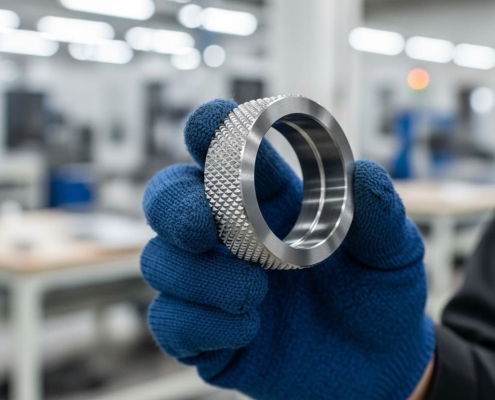
How Does Knurling Work?
The knurling process typically involves a knurling tool, which consists of one or more hardened steel wheels with the desired pattern machined into their circumference. When these wheels are pressed against a rotating workpiece, the pattern is transferred onto the surface.
In form knurling, the material is displaced and pushed up to create the pattern. This causes the outside diameter of the part to increase slightly. In contrast, cut knurling involves removing material, similar to a threading operation on a lathe machine, where sharp teeth on the knurling tool cut into the workpiece, maintaining the original diameter or slightly reducing it. The selection between these methods significantly impacts material integrity and dimensional accuracy.
Exploring Different Types of Knurling
The versatility of knurling stems from the variety of techniques and patterns available, each suited for distinct functional and aesthetic requirements. Understanding these knurl types is essential for optimal application.
1. By Process Method
Form Knurling
This technique relies on applying significant pressure to the material surface using knurling wheels, which displace the metal to form the pattern. It is fast, cost-effective, and produces a work-hardened surface. However, it requires ductile materials like aluminum, brass, or mild steel to prevent cracking, and the part diameter increases slightly.
Cut Knurling:
This method uses sharp knurling wheels to cut small chips, similar to a light milling process. It requires less force, delivers a cleaner and more precise finish, and works well with harder or brittle materials such as stainless steel or alloys. Unlike form knurling, it can maintain or even slightly reduce the original diameter.
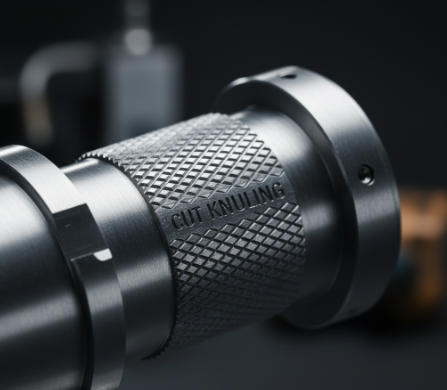
2. By Common Knurling Patterns
Straight Knurling:
This design produces parallel lines along the axis of the workpiece. It is simple, functional, and provides a linear grip, making it ideal for push-pull parts or decorative applications.
Diagonal Knurling:
Also known as spiral or helical knurling, this pattern is created by angled lines running along the workpiece surface. It provides directional grip, making it suitable for knobs or parts that require controlled rotation.
Diamond Knurling:
The most recognizable knurling pattern, created by intersecting diagonal lines to form diamond shapes. It offers strong, multidirectional grip, preventing slippage in hand-operated components such as tools, handles, or adjustment screws.
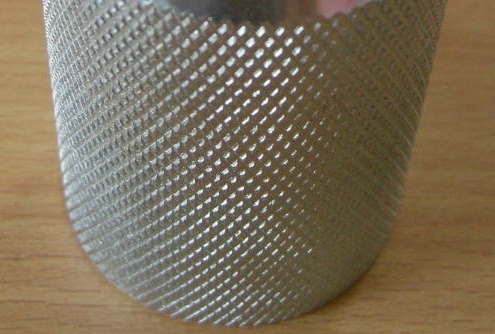
3. By Specialized Knurling Techniques
Annular Knurling:
This type forms concentric rings around the workpiece, often used in electrical contacts or for axial locking of components. Its circular grooves provide reliable engagement without requiring deep penetration into the material.
Convex and Concave Knurling:
These customized knurling techniques are designed for non-cylindrical or uniquely shaped surfaces. Convex or concave knurls can improve grip, aesthetics, or functional performance for specialized applications, offering manufacturers greater flexibility in product design.
Knurling Types Summary
| Type | Description | Best Suited Materials | Key Applications |
|---|---|---|---|
| Form Knurling (Displacement) | Uses pressure to displace material with knurling wheels. Fast, cost-effective, and work-hardens the surface, but increases part diameter slightly. | Ductile metals (aluminum, brass, mild steel) | General gripping surfaces, press-fit components |
| Cut Knurling | Sharp knurling wheels cut chips from the surface, producing a cleaner and more precise pattern. Requires less force and maintains diameter. | Harder or brittle metals (stainless steel, alloys) | Precision parts, thin-walled components, decorative finishes |
| Straight Knurling | Produces parallel lines along the workpiece axis, offering linear grip and a simple visual style. | Most metals and plastics | Push-pull parts, decorative surfaces |
| Diagonal Knurling | Creates angled lines (spiral/helical) that provide directional grip. | Metals, plastics | Knobs, rotary parts needing controlled rotation |
| Diamond Knurling | Intersecting diagonals form diamond shapes. Strong, multi-directional grip prevents slippage. | Metals, plastics | Hand tools, adjustment screws, handles |
| Annular Knurling | Produces concentric rings around the part. Ensures axial locking or electrical contact reliability. | Metals for electrical/mechanical applications | Electrical connectors, axial retention features |
| Convex / Concave Knurling | Custom knurling for non-cylindrical or special geometries, enhancing grip or aesthetics. | Depends on application | Special-purpose components, custom grip solutions |
Key Advantages of Implementing Knurling
The strategic application of knurling offers a multitude of benefits that extend beyond basic surface texturing, significantly impacting product functionality, assembly, and overall cost-effectiveness. These knurling advantages make it a preferred choice in many manufacturing scenarios.
1. Enhancing Grip and Ergonomics
The most immediate and apparent benefit of knurling is the improvement in grip. By creating a textured surface, knurling drastically increases the coefficient of friction between a user’s hand (or a tool) and the component. This is crucial for parts that require manual operation, such as control knobs, handles, or medical instruments, ensuring a secure hold even in wet or oily conditions. Enhanced ergonomics lead to safer operation and reduced user fatigue.
2. Improving Assembly and Fastening Strength
Knurling plays a vital role in mechanical assemblies, particularly in applications requiring press-fits or overmolding. A knurled surface provides increased resistance against rotation and axial pull-out when pressed into a mating part, offering a superior alternative to smooth surfaces. This eliminates the need for additional fasteners or adhesives in some cases, simplifying assembly processes.
For example, when a plastic component is molded over a metal insert, the knurled pattern creates mechanical interlocks that prevent the insert from rotating or detaching. This also applies to securing a square on shaft for torque transmission.
3. Aesthetic and Decorative Benefits
Beyond functionality, knurling offers significant aesthetic appeal. A precisely knurled surface can impart a professional, high-quality look to a product, elevating its perceived value. This decorative aspect is particularly important in consumer goods, luxury items, and instruments where appearance is as crucial as performance. Knurling patterns can be customized to match specific design requirements, contributing to brand identity and product differentiation.
4. Cost-Effectiveness and Material Efficiency
Knurling is a remarkably cost-effective process. Compared to complex machining operations or the addition of extra components to achieve similar grip or fastening properties, knurling is relatively fast and inexpensive to implement. In many cases, it utilizes existing lathe machines, minimizing capital expenditure.
Furthermore, form knurling, by displacing rather than removing material, promotes material efficiency, reducing waste. This aligns with modern manufacturing goals of sustainability and cost reduction, making it a valuable technique for any CNC machining manufacturer.
What Are the Practical Applications of Knurling in Industry?
The diverse knurling applications demonstrate its ubiquitous presence across various sectors, from precision instruments to heavy machinery. Its adaptability makes it invaluable for numerous functional and aesthetic requirements.
| Industry / Sector | Application Examples | Purpose & Benefits |
|---|---|---|
| Medical Devices & Instruments | Surgical tools, dental instruments, precision medical devices | Ensures a secure, sterile, and non-slip grip even with gloves or fluids, improving safety and accuracy during procedures |
| Hand Tools & Sporting Equipment | Wrenches, screwdrivers, barbells, golf club grips | Provides friction and durability, preventing slips and ensuring efficient force application under heavy or repetitive use |
| Automotive & Aerospace Components | Rotary shafts, gear shifter knobs, control panels, press-fit components | Enables secure fastening, vibration reduction, and tactile feedback. Precision knurling via CNC machining enhances durability and reliability |
| Consumer Goods & Everyday Items | Flashlights, camera dials, bicycle pedals, premium pens | Delivers better grip, tactile appeal, and premium aesthetics, enhancing overall user experience and product perception |
Case Study: VMT Improves Medical Device Safety with Precision Knurling
A leading medical device manufacturer presented VMT with a challenge: its existing supplier struggled to consistently produce fine-pitch diamond knurls on a critical stainless steel surgical instrument component. Inconsistent knurl quality resulted in an unstable grip for surgeons, increased risk of slippage during delicate procedures, and high scrap rates.
VMT’s engineering team, leveraging its expertise as a CNC machine manufacturer and knurling tool manufacturer, conducted a comprehensive analysis. We recommended converting the form knurling process to a specialized cut knurling process and optimized the knurling speeds and feeds for medical-grade stainless steel. We also designed a custom knurling tool to achieve the precise, fine-pitch diamond pattern required.
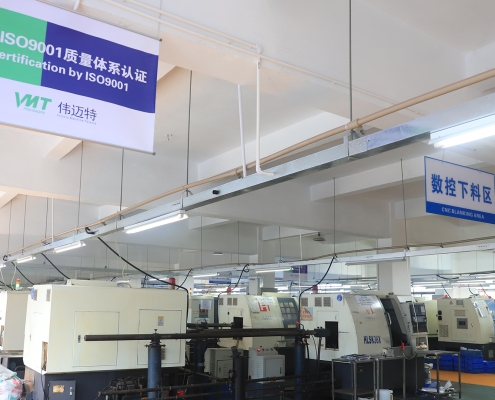
The implementation of VMT’s solution significantly improved knurl consistency and quality. Scrap rates for the component decreased by 70%, and the customer reported significantly improved tactile feedback and grip stability in their surgical instruments. This not only improved product safety and performance but also resulted in significant cost savings by reducing material waste and rework. Contact us today to get a free quote for your CNC machining and knurling project!
In Conclusion
Knurling is a practical and versatile machining process that improves grip, strengthens assemblies, enhances aesthetics, and increases product reliability. A clear understanding of its working principles, types, and applications helps engineers and manufacturers achieve better performance and efficiency in production.
Frequently Asked Questions
Can knurling be done on a flat surface?
Yes, knurling flat surface is possible, though it requires specialized equipment, often a knurling press or a dedicated knurling machine, rather than a standard lathe which is typically for cylindrical parts. The principle remains the same: a knurling die or wheel is pressed against the flat surface to emboss or cut the desired pattern.
How do you perform knurling on a CNC lathe?
Performing knurling on a CNC lathe involves mounting a knurling tool in the tool post and programming the CNC machine for the correct knurling speeds and feeds, depth of plunge, and feed rate. For form knurling, the tool is gradually fed into the workpiece, applying pressure. For cut knurling, the tool’s cutting wheels are fed into the material, removing chips to create the pattern, similar to a threading operation on lathe machine but with a different tool. Precision control offered by CNC machining is crucial for consistent results.
What are the different knurl types available?
The most common knurl types are straight, diagonal (or helical), and diamond. Straight knurling produces parallel lines, diagonal creates angled parallel lines, and diamond knurling results from two sets of intersecting diagonal lines. Specialized types like annular, convex, or concave knurling are also available for specific applications.
What are the common challenges with aluminum knurling?
Aluminum knurling can present specific challenges due to the material’s softness and tendency to gum up. Form knurling on aluminum can cause excessive material displacement or smearing if not properly controlled.
Cut knurling is often preferred for aluminum as it removes material cleanly, but requires sharp tools and careful selection of knurling speeds and feeds to prevent chip buildup and ensure a crisp pattern. Proper lubrication is also critical.
What is the significance of "definition impearled" in knurling?
The term “definition impearled” describes the high-quality, distinct, and pearl-like appearance of a well-executed knurled surface. It signifies that the knurling pattern is sharp, uniform, and clearly defined across the entire textured area, without any smearing, unevenness, or missing portions. Achieving a “definition impearled” finish is a benchmark of precision and quality in the knurling process.

